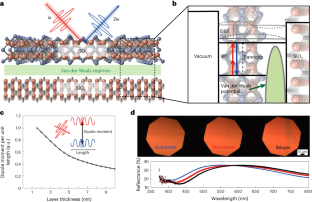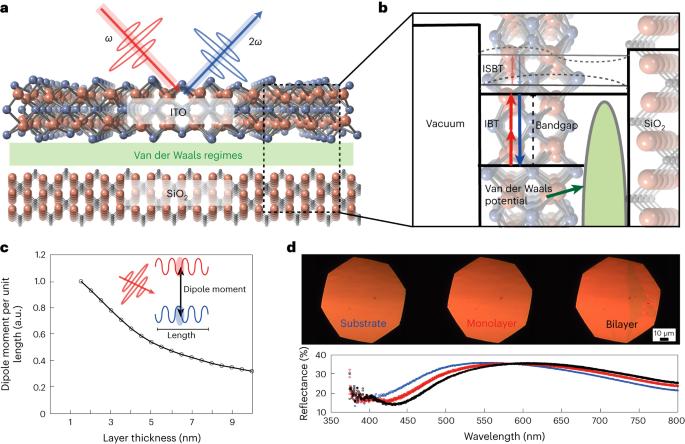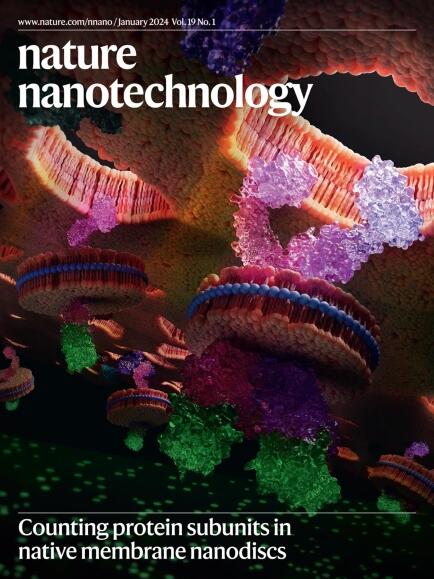Large second-order susceptibility from a quantized indium tin oxide monolayer
IF 34.9
1区 材料科学
Q1 MATERIALS SCIENCE, MULTIDISCIPLINARY
引用次数: 0
Abstract
Due to their high optical transparency and electrical conductivity, indium tin oxide thin films are a promising material for photonic circuit design and applications. However, their weak optical nonlinearity has been a substantial barrier to nonlinear signal processing applications. In this study, we show that an atomically thin (~1.5 nm) indium tin oxide film in the form of an air/indium tin oxide/SiO2 quantum well exhibits a second-order susceptibility χ2 of ~1,800 pm V–1. First-principles calculations and quantum electrostatic modelling point to an electronic interband transition resonance in the asymmetric potential energy of the quantum well as the reason for this large χ2 value. As the χ2 value is more than 20 times higher than that of the traditional nonlinear LiNbO3 crystal, our indium tin oxide quantum well design can be an important step towards nonlinear photonic circuit applications. An atomically thin indium tin oxide film in the form of a quantum well exhibits a χ2 of ~1,800 pm V–1. Theoretical calculations point to an asymmetric electronic interband transition resonance as the reason for this large χ2 value.


来自量子化氧化铟锡单层的大二阶感性
由于具有高光学透明度和导电性,氧化铟锡薄膜是一种很有前途的光子电路设计和应用材料。然而,其微弱的光学非线性一直是非线性信号处理应用的一大障碍。在本研究中,我们展示了以空气/氧化铟锡/二氧化硅量子阱形式存在的原子级薄(约 1.5 nm)氧化铟锡薄膜,其二阶电感χ2 约为 1,800 pm V-1。第一原理计算和量子静电建模表明,量子阱不对称势能中的电子带间转变共振是产生如此大的 χ2 值的原因。由于χ2 值比传统非线性 LiNbO3 晶体的χ2 值高出 20 多倍,我们的氧化铟锡量子阱设计可以说是向非线性光子电路应用迈出的重要一步。
本文章由计算机程序翻译,如有差异,请以英文原文为准。
求助全文
约1分钟内获得全文
求助全文
来源期刊

Nature nanotechnology
工程技术-材料科学:综合
CiteScore
59.70
自引率
0.80%
发文量
196
审稿时长
4-8 weeks
期刊介绍:
Nature Nanotechnology is a prestigious journal that publishes high-quality papers in various areas of nanoscience and nanotechnology. The journal focuses on the design, characterization, and production of structures, devices, and systems that manipulate and control materials at atomic, molecular, and macromolecular scales. It encompasses both bottom-up and top-down approaches, as well as their combinations.
Furthermore, Nature Nanotechnology fosters the exchange of ideas among researchers from diverse disciplines such as chemistry, physics, material science, biomedical research, engineering, and more. It promotes collaboration at the forefront of this multidisciplinary field. The journal covers a wide range of topics, from fundamental research in physics, chemistry, and biology, including computational work and simulations, to the development of innovative devices and technologies for various industrial sectors such as information technology, medicine, manufacturing, high-performance materials, energy, and environmental technologies. It includes coverage of organic, inorganic, and hybrid materials.
 求助内容:
求助内容: 应助结果提醒方式:
应助结果提醒方式:


